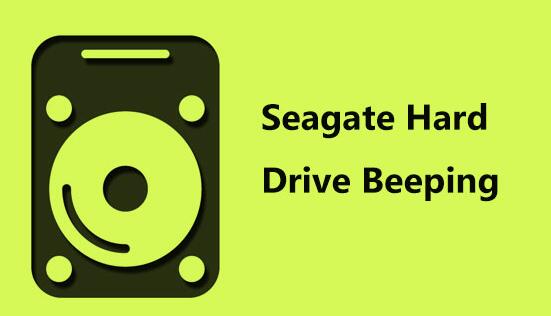When a Seagate hard drive starts beeping and is not recognized by your computer, it’s a sign that something is wrong. The beeping sound often indicates a hardware issue, which can range from minor to severe.
1. Beeping Sound
1.1. Common Causes of Beeping
A Seagate hard drive beeping can be attributed to several potential issues:
Power Supply Problems: Inadequate or unstable power supply can cause the drive to beep. This could be due to a faulty cable or power connector.
Drive Malfunction: Mechanical failures within the drive, such as issues with the read/write heads or platters, can lead to beeping.

Internal Damage: Physical damage to the drive, such as from dropping or severe impacts, might result in beeping sounds.
Firmware Issues: Corruption or bugs in the drive’s firmware can sometimes cause unusual sounds, including beeping.
1.2. Types of Beeping Sounds
Continuous Beeping: A continuous beep often indicates a more serious problem, such as a power issue or a severe mechanical failure.
Intermittent Beeping: Intermittent beeping may suggest a loose connection or minor mechanical issues.
2. Troubleshooting Steps
2.1. Check Connections
Verify Power Supply: Ensure that the power supply to the drive is stable and properly connected. Test with another power adapter if available.
Inspect Cables: Check all data and power cables for damage. Try using different cables to rule out a faulty cable issue.
Reconnect the Drive: Disconnect and reconnect the hard drive to see if the problem persists.
2.2. Test on Another Computer
Connect to a Different PC: Sometimes, the issue might be related to the computer rather than the hard drive. Connect the drive to a different computer to check if it is recognized.
2.3. Use Diagnostic Tools
Seagate Diagnostic Software: Seagate provides diagnostic tools like SeaTools, which can help identify issues with the drive.
SMART Status: Check the drive’s SMART (Self-Monitoring, Analysis, and Reporting Technology) status for any warnings or errors.
2.4. Listen for Sounds
Clicking or Grinding: If the drive is making clicking or grinding sounds along with beeping, it could indicate a serious mechanical failure that requires professional help.
No Sound: If there is no sound at all, it might be an indication of a power or connection issue.
3. Data Recovery Considerations
3.1. Importance of Data Backup
Regular Backups: Regularly backing up your data is crucial to prevent data loss. If your drive is making unusual sounds, it’s a good time to ensure you have backups of important files.
Backup Strategies: Use external drives, cloud storage, or other backup solutions to keep your data safe.
3.2. Professional Data Recovery Services
When to Seek Help: If you hear beeping and the drive is not recognized, it may be best to consult a professional data recovery service. They have specialized tools and expertise to recover data from damaged drives.
Choosing a Service: Look for services with good reviews, a track record of successful recoveries, and a transparent process.
4. Preventive Measures
4.1. Proper Handling
Avoid Physical Impact: Handle your hard drive carefully to avoid physical damage.
Environmental Conditions: Keep the drive in a stable, dust-free environment with proper ventilation.
4.2. Regular Maintenance
Firmware Updates: Keep your drive’s firmware up to date to avoid potential issues.
Disk Health Monitoring: Regularly check the health of your drive using diagnostic tools.
4.3. Safe Ejection
Proper Disconnection: Always use the ‘Safely Remove Hardware’ feature on your computer before unplugging the drive to avoid data corruption.
The beeping sound from a Seagate hard drive and its lack of recognition can be distressing, but understanding the potential causes and troubleshooting steps can help you address the issue effectively. If the problem persists or you’re unable to recover your data, seeking professional help is advisable. Remember, regular backups and proper drive maintenance are key to preventing data loss and ensuring the longevity of your hard drive.
About us and this blog
Panda Assistant is built on the latest data recovery algorithms, ensuring that no file is too damaged, too lost, or too corrupted to be recovered.
Request a free quote
We believe that data recovery shouldn’t be a daunting task. That’s why we’ve designed Panda Assistant to be as easy to use as it is powerful. With a few clicks, you can initiate a scan, preview recoverable files, and restore your data all within a matter of minutes.
Subscribe to our newsletter!
More from our blog
See all postsRecent Posts
- Recovery ssd upgrade failed exagrid error 2025-04-03
- Smart hard disk error 301 2025-04-03
- Error code 36 external hard drive 2025-04-03










